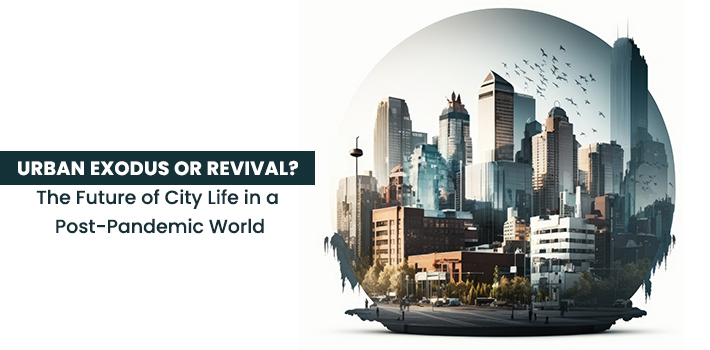Urban Exodus or Revival? The Future of City Life in a Post-Pandemic World
The COVID-19 pandemic fundamentally changed how we live, do our work, and interact. As a result of this, busy cityscapes turned into quiet places due to the lockdowns. When the world is gradually recovering from this crisis today; one query remains very important; what will cities be like in the future? Is an urban exodus going on or are they going to be active again?
Here's A Closer Look at The Forces Shaping the Post-Pandemic Cityscape:
- The Rise of Remote Work: The pandemic led to the widespread adoption of remote work by many professionals. They can now think about their living conditions, not considering long trips every morning or evening. This trend could lead to depopulation in megacities as people search for cheaper housing and a quieter life away from busy cities.
- Rethinking Density: The high-density urban areas were breeding places for the spread of the disease. Such an experience may result in increased demand for less crowded homes such as suburban sprawl or satellite townships which avail better facilities for personal vehicle transport.
- The Yearning for Green Spaces: During the lockdowns, it was observed that access to green spaces was very important. Such developments can make neighborhoods attractive due to parks, gardens, or balconies and help increase mixed-use development that integrates nature into the fabric of a city.
- A Flight to Affordability: Thus, in major cities, COVID-19’s economic effects may worsen problems with housing affordability even further. Similarly, consequently, the rising cost of living might push dwellers towards smaller towns or suburban areas where they can get more value for their money.
- The Pull of Urban Amenities: However, in cities, there are different cultural attractions like various populations and job opportunities. Even after the pandemic, this dynamism is expected to attract young professionals and entrepreneurs thus leading to urban renaissance post-pandemic.
- Transforming through Tech: The COVID-19 pandemic catalyzed the adoption of smart technology in urban planning. Few responses were contactless services and improved connectivity of public transportation aimed at improving the quality of life in towns for better effectiveness and sustainability.
- Focus on Public Health: When a pandemic situation happens, some courts can be biased towards cities regarding public health infrastructures. This may also include increased investments in sanitation, medical infrastructure as well as proper surveillance systems to prevent epidemics.
- The Value of Community: Through the COVID-19 pandemic it was clearly shown how much humans need each other. Consequently, some city dwellers might initiate community-based initiatives once more while calling for stronger social connections among themselves thereby reclaiming their neighborhoods’ sense of identity.
The Future is Fluid:
It is not easy to predict what the future of cities will look like. The way these factors interact will vary with a specific city, its economic base, and the tastes of its population.
Possible Scenarios:
- The Tech Hub Metropolis: For example, certain cities that have a vibrant tech industry might still attract more talented people engaged in the search for jobs and inventions. These cities may become centers for advanced technology development and urban planning.
- The Fragmented City: Meanwhile, some cities could witness central business districts (CBDs) hollowing out due to remote working becoming standard. This would mean that there are few towns within an urban area some of which are thriving while others are declining.
- The Live-Work-Play City: They could help make mixed-use development, green spaces, and walkable neighborhoods a priority. Such cities may appeal to inhabitants in quest of comprehensive life patterns encompassing work, relaxation, and society.
The Bottom Line:
It is not choosing between abandoning cities or reviving them as they were before. Rather it is a set of possibilities lying across a spectrum defined by local conditions and resident preferences. Cities that refocus themselves on technology, public health, and communal spirit in response to post-pandemic realities will be successful.


